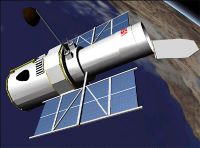Difference between revisions of "Hubble Space Telescope"
(Category link) |
(Added category.) |
||
| (9 intermediate revisions by 6 users not shown) | |||
| Line 1: | Line 1: | ||
| − | The Hubble Space Telescope is the visible/ultraviolet/near-infrared element of the Great Observatories | + | [[Image:HST.jpg|200px|thumb|right|Hubble Space Telescope]] |
| + | The '''Hubble Space Telescope''' is the visible/ultraviolet/near-infrared element of the [[Great Observatories]] | ||
astronomical program. | astronomical program. | ||
The spacecraft provides an order of magnitude better resolution than is capable from ground-based telescopes. The objectives of the HST are to: | The spacecraft provides an order of magnitude better resolution than is capable from ground-based telescopes. The objectives of the HST are to: | ||
| − | + | # Investigate the composition, physical characteristics, and dynamics of celestial bodies; | |
| − | + | # Examine the formation, structure, and evolution of stars and galaxies; | |
| − | + | # Study the history and evolution of the universe; | |
| − | + | # Provide a long-term space-based research facility for optical astronomy. | |
During initial on-orbit checkout of the Hubble's systems, a flaw in the telescope's main reflective mirror was found that prevented perfect focus of the incoming light. | During initial on-orbit checkout of the Hubble's systems, a flaw in the telescope's main reflective mirror was found that prevented perfect focus of the incoming light. | ||
This flaw was caused by the incorrect adjustment of a testing device used in building the mirror. | This flaw was caused by the incorrect adjustment of a testing device used in building the mirror. | ||
| − | Fortunately, however, Hubble was designed for regular on-orbit maintenance by Shuttle missions. The first servicing mission, STS-61 in December 1993, fully corrected the problem by installing a corrective optics package and upgraded instruments (as well as replacing other satellite components). A second servicing mission, scheduled for March 1997, installed two new instruments in the observatory. | + | Fortunately, however, Hubble was designed for regular on-orbit maintenance by [[Space Shuttle]] missions. The first servicing mission, [[STS-61]] in December [[1993]], fully corrected the problem by installing a corrective optics package and upgraded instruments (as well as replacing other satellite components). A second servicing mission, scheduled for March [[1997]], installed two new instruments in the observatory. |
| + | [[Category: Articles]] | ||
[[Category:Historic spacecraft]] | [[Category:Historic spacecraft]] | ||
| + | [[Category:Vessels of Orbiter]] | ||
Latest revision as of 11:25, 14 October 2022
The Hubble Space Telescope is the visible/ultraviolet/near-infrared element of the Great Observatories astronomical program. The spacecraft provides an order of magnitude better resolution than is capable from ground-based telescopes. The objectives of the HST are to:
- Investigate the composition, physical characteristics, and dynamics of celestial bodies;
- Examine the formation, structure, and evolution of stars and galaxies;
- Study the history and evolution of the universe;
- Provide a long-term space-based research facility for optical astronomy.
During initial on-orbit checkout of the Hubble's systems, a flaw in the telescope's main reflective mirror was found that prevented perfect focus of the incoming light. This flaw was caused by the incorrect adjustment of a testing device used in building the mirror. Fortunately, however, Hubble was designed for regular on-orbit maintenance by Space Shuttle missions. The first servicing mission, STS-61 in December 1993, fully corrected the problem by installing a corrective optics package and upgraded instruments (as well as replacing other satellite components). A second servicing mission, scheduled for March 1997, installed two new instruments in the observatory.
